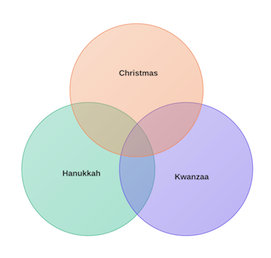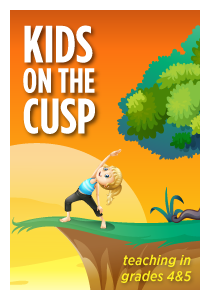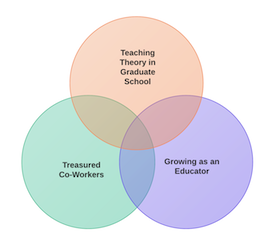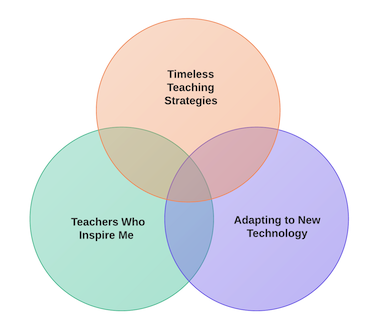Continuing Resolutions: Circles within Circles
 A MiddleWeb Blog
A MiddleWeb Blog
I stopped making New Year’s resolutions. I used to make them, but they never lasted very long. Nowadays, my resolutions seem to occur on a daily basis. It’s in the job description.
Actually, I don’t recall ever seeing a job description for being a teacher. Perhaps the closest thing to an official description lies in the state-sanctioned rubrics I’ve been using to analyze my ability to perform this job. I get paid to teach, so, technically, it is a job. But what is a teacher?
I work with many people who love to teach. Observing them in action, seeing them with their students, helps me describe a large part of the job. These are the people I picture when I ponder my own, personal job description.
I often define my teaching based on my colleagues and the magic I see in their practice. Much of their enthusiasm sparks mine, and I recognize some of our shared gifts. I see similarities to my own strengths, and I see the things that are lacking in my own teaching. That’s when my resolutions seem to be made.
Rubrics are one component to use in describing the work of teachers, but the people I work with each day are the ones who truly help define my career.
Channeling Mrs. Dura
The talent pool in our school is large, and this fish sure likes swimming around in the swift current. The other Mary is one of the people I swim with each day. I respect her knowledge and her ability (and willingness) to share this knowledge with all who want to discuss education practices and theory. She is earnest about her interest in the lives of her colleagues and her students, and has spoken many pearls of wisdom (wisdom that she would never take credit for).
Mary Dura is the most patient woman I know. She teaches second grade now, but I always think of her as a first grade teacher. She filled that role for many years, so I keep her there in my mind, as an inspiration to stay patient with my fourth graders. I channel the other Mary when I need her (literally…she gave me permission).
“Should we take the Mrs. Dura approach?” I ask my students. The response is always a definite yes. Then I clasp my hands in front of me and prepare to alter my voice into the sweet lilt that only preschool, kindergarten, and first grade teachers possess.
“Boys and girls, today we are going to put on our thinking caps.”
Smiles slide onto their faces, as they think back to their first grade experience, a time of great innocence (remember, they are cool fourth graders now). I watch them go back to a time when life was simple, and snack was still an integral part of the school day. It’s fun to “teach first grade.” It’s fun to be the other Mary.
Mary has been teaching for about thirty years. She remembers “old school.” She also tries to embrace the new. She sees a need for both. Old school and new age can live happily together.
Holiday Venns
A triple Venn Diagram can be projected on an interactive board and used in a multitude of high-end thinking activities using technology. The same triple Venn can be used to teach 40-something six to ten year olds, huddled together on a rug, the week before holiday break.
My friend Melissa and I planned this buddy activity. Melissa, like the other Mary, is a veteran first grade teacher. These gifted women worked together for years and share many of the same strengths and gifts. I have admired Melissa as a teacher, and as a person, since I worked as an aide in her classroom over 15 years ago. Her brand of magic often turns into one of my resolutions.
For this holiday activity, we used a triple-Venn (along with our fourth grade experts) to help our first grade buddies classify and categorize. 
Since most of the kids were either Christian or Jewish, we had an easy time using their prior schema to compile a list of holiday symbols, traditions, and beliefs. Then we read a short, non-fiction picture book about Kwanzaa. There was virtually no prior schema with regard to the celebration of Kwanzaa. Our school has many different nationalities, but there were none who were aware of any roots tracing back to Africa.
The kids found some commonalities within these three separate holidays. They found that there are gifts involved in every one (Melissa and I saw that one coming). But they also figured out some bigger similarities. They made the connection we were hoping for – that Christmas, Hanukkah and Kwanzaa all celebrate family and friends, that giving and love were a shared theme in these three unique celebrations.
*****
The celebration of Hanukkah has passed. Christmas is upon us, and Kwanzaa begins on the 26th and ends on January 1, 2014…the first day of the New Year.
My official New Year’s resolution this year will be to continue making just-in-time resolutions, as education changes, new technology explodes, and our global world gets smaller.
A few nights after our Kwanzaa lesson, I sat in a restaurant enjoying our staff holiday party. The First Grade team had reserved a party room for us in the back of the busy Italian eatery. Glasses were clinking merrily. Chatter and laughter filled the room.
I took a moment to lean back in my chair and look at the people making all the noise. Scanning the crowd, I reflected on the many lessons I had learned from these dedicated people, and the resolutions they had inspired over the years.
It was a bittersweet moment. Only a handful of these colleagues had been at our school when I arrived. There were many newer faces who had found their way to our red brick community throughout the years. This cast of characters was sitting at various tables throughout the room.
The moment was even more bittersweet because of the setting. As teachers of language and literacy, we know the setting plays an integral part in every story. This restaurant was the restaurant where I had worked to pay for graduate school. It was the restaurant my former high school principal had been eating in, so many years ago, when he volunteered his wife to serve as my mentor teacher.
Now, more than 20 years later, I sat in that same restaurant, reminiscing about the career path I had chosen, mentally completing my own triple Venn.
I think a triple Venn diagram can also serve as a tool to help define my own personal job description. I think my official New Year’s Resolution for 2014 will be to pursue another continually evolving Venn:







































Beautiful Mary, as you are! Thank you for sharing your journey of inspiration. It has inspired me. Love you
Being a Mary has its moments …Thank you, Mary D…
This is a very thought provoking post. It makes me think about my own context of working toward comprehensive inclusive education for students with complex needs. It helps to frame the push and pull of “academic/intellectual” growth, “social/emotional” growth and what people traditionally call “life skills” (which should ultimately be about living self-determined lives). The type of education that we are trying to achieve sits in the center of those three circles. When we don’t have the cross over we end up with segregation or integration or mainstreaming rather than inclusive education. Inclusive education is about the package… delivering a whole child education. Placement then becomes a matter of where we can do that. It’s interesting. What you have written might inspire a blog post of my own. Thank you.
Thank you for your comments and insights…Would love to read that post when you write it!…Sometimes when I have trouble connecting the dots within education, the circle approach works better for me…